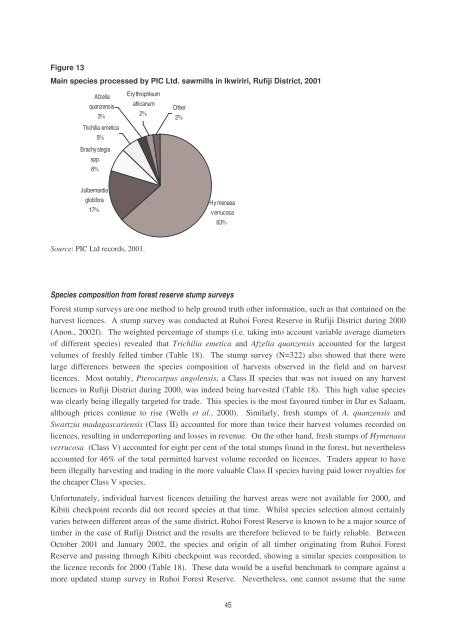Bridging the Gap: linking timber trade with infrastructural ...
Bridging the Gap: linking timber trade with infrastructural ...
Bridging the Gap: linking timber trade with infrastructural ...
You also want an ePaper? Increase the reach of your titles
YUMPU automatically turns print PDFs into web optimized ePapers that Google loves.
Figure 13<br />
Main species processed by PIC Ltd. sawmills in Ikwiriri, Rufiji District, 2001<br />
Afzelia<br />
quanzensis<br />
3%<br />
Trichilia emetica<br />
5%<br />
Brachystegia<br />
spp.<br />
8%<br />
Erythrophleum<br />
africanum<br />
2%<br />
O<strong>the</strong>r<br />
2%<br />
Julbernardia<br />
globifora<br />
17%<br />
Hymenaea<br />
verrucosa<br />
63%<br />
Source: PIC Ltd records, 2001.<br />
Species composition from forest reserve stump surveys<br />
Forest stump surveys are one method to help ground truth o<strong>the</strong>r information, such as that contained on <strong>the</strong><br />
harvest licences. A stump survey was conducted at Ruhoi Forest Reserve in Rufiji District during 2000<br />
(Anon., 2002f). The weighted percentage of stumps (i.e. taking into account variable average diameters<br />
of different species) revealed that Trichilia emetica and Afzelia quanzensis accounted for <strong>the</strong> largest<br />
volumes of freshly felled <strong>timber</strong> (Table 18). The stump survey (N=322) also showed that <strong>the</strong>re were<br />
large differences between <strong>the</strong> species composition of harvests observed in <strong>the</strong> field and on harvest<br />
licences. Most notably, Pterocarpus angolensis, a Class II species that was not issued on any harvest<br />
licences in Rufiji District during 2000, was indeed being harvested (Table 18). This high value species<br />
was clearly being illegally targeted for <strong>trade</strong>. This species is <strong>the</strong> most favoured <strong>timber</strong> in Dar es Salaam,<br />
although prices continue to rise (Wells et al., 2000). Similarly, fresh stumps of A. quanzensis and<br />
Swartzia madagascariensis (Class II) accounted for more than twice <strong>the</strong>ir harvest volumes recorded on<br />
licences, resulting in underreporting and losses in revenue. On <strong>the</strong> o<strong>the</strong>r hand, fresh stumps of Hymenaea<br />
verrucosa (Class V) accounted for eight per cent of <strong>the</strong> total stumps found in <strong>the</strong> forest, but never<strong>the</strong>less<br />
accounted for 46% of <strong>the</strong> total permitted harvest volume recorded on licences. Traders appear to have<br />
been illegally harvesting and trading in <strong>the</strong> more valuable Class II species having paid lower royalties for<br />
<strong>the</strong> cheaper Class V species.<br />
Unfortunately, individual harvest licences detailing <strong>the</strong> harvest areas were not available for 2000, and<br />
Kibiti checkpoint records did not record species at that time. Whilst species selection almost certainly<br />
varies between different areas of <strong>the</strong> same district, Ruhoi Forest Reserve is known to be a major source of<br />
<strong>timber</strong> in <strong>the</strong> case of Rufiji District and <strong>the</strong> results are <strong>the</strong>refore believed to be fairly reliable. Between<br />
October 2001 and January 2002, <strong>the</strong> species and origin of all <strong>timber</strong> originating from Ruhoi Forest<br />
Reserve and passing through Kibiti checkpoint was recorded, showing a similar species composition to<br />
<strong>the</strong> licence records for 2000 (Table 18). These data would be a useful benchmark to compare against a<br />
more updated stump survey in Ruhoi Forest Reserve. Never<strong>the</strong>less, one cannot assume that <strong>the</strong> same<br />
45
















